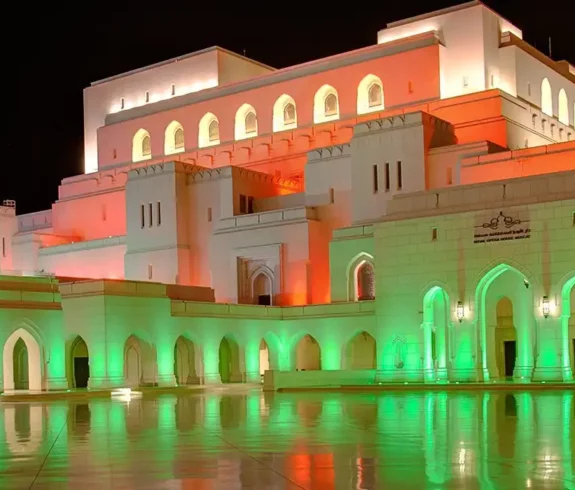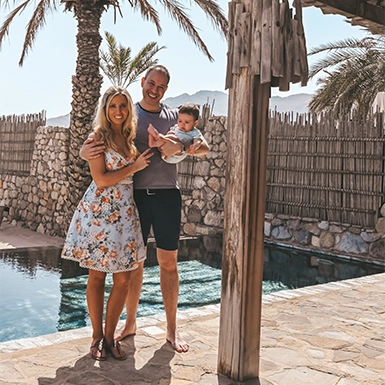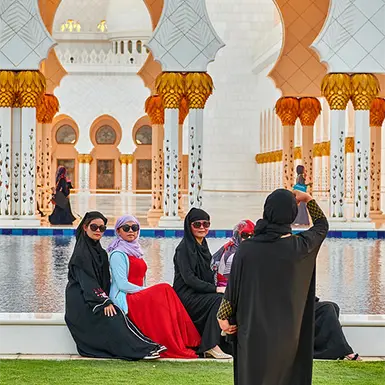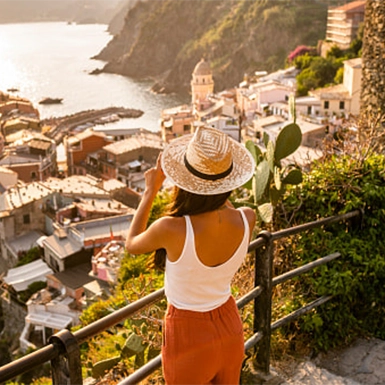The Royal Opera House Muscat is a prominent cultural landmark in Oman. Located in the heart of Muscat, this architectural masterpiece attracts attention for its beauty and world-class performances. The opera house actively promotes arts and culture in Oman, offering an exceptional venue for opera, ballet, classical music, and exhibitions.
It is one of the most prominent cultural institutions in the Middle East and upholds Oman’s heritage while integrating with the world’s artistry. The institution harmoniously blends traditional values with modern advancements and embodies Oman’s vision of progress.
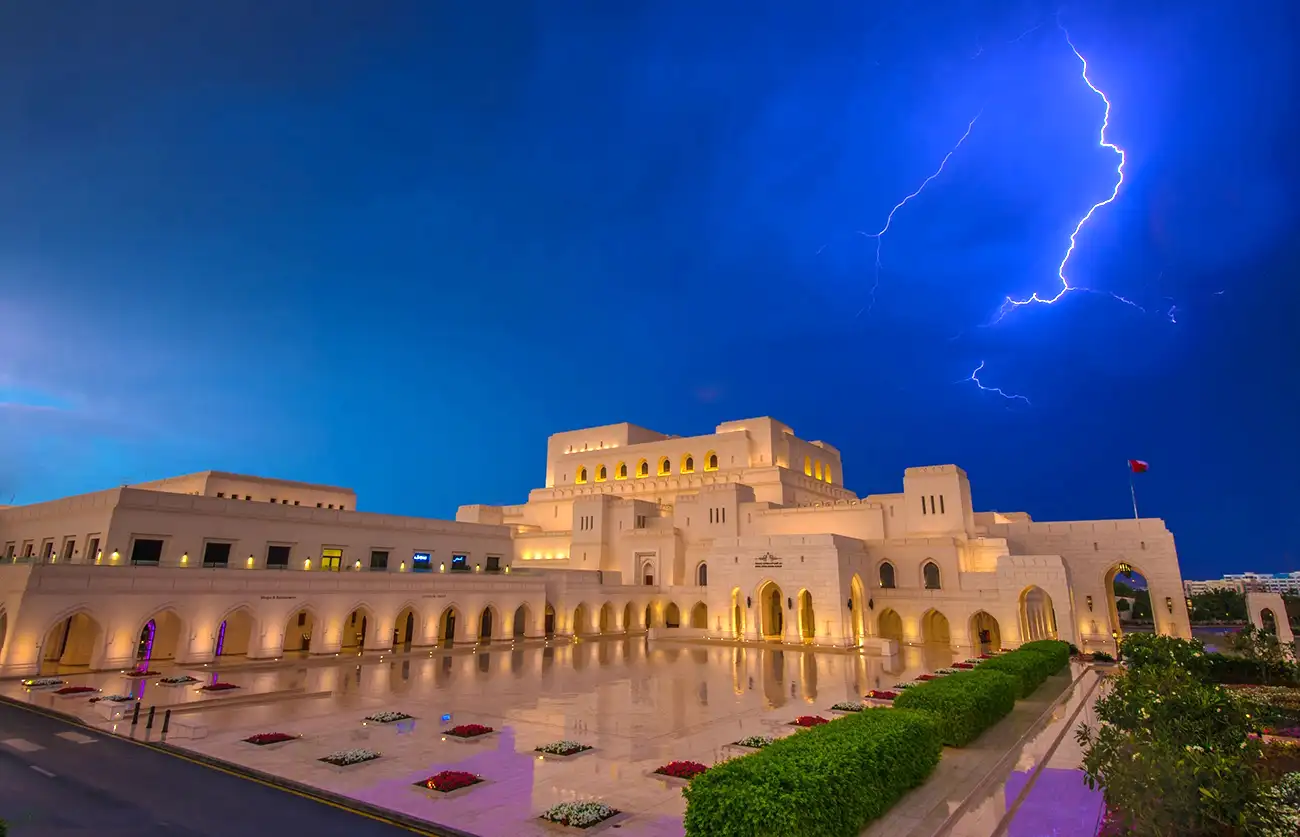
Establishment and Significance of the Royal Opera House Muscat
- Inception and Construction: In 2011, Sultan Qaboos Bin Said opened the Royal Opera House in Muscat, a project aimed at building a cultural center for the artistic expression and exchange of the world. Hence, the outlay also incorporates modern contemporary features and Omani-style architecture, thus making it a landmark in Muscat.
- Architectural Masterpiece: The design of the opera building incorporates the traditional Mother of Pearl artistic works of the Oman people and employs the most modern technology. It has Intricate Zalia work, lofty halls, and an ultra-modern concert hall, making it one of the most sophisticated opera houses in the Middle East.
- Cultural Hub of Oman: The opera house regularly hosts performances by international and local artists, enhancing Oman’s cultural dialogue. It is a platform for world-renowned orchestras, acclaimed soloists, and Omani cultural showcases, promoting exchanging ideas and traditions.
- Educational and Social Contribution: Besides its performances, the venue plays an essential role in arts education. Through workshops and masterclasses, the Royal Opera House Muscat encourages budding artists and musicians, fostering greater interest in the arts among the local population.
- Impact on Tourism and Economy: The opera house significantly boosts Oman’s tourism by attracting visitors from around the world. Travelers come to Muscat to experience its performances, support the local economy, and enhance Oman’s global cultural standing.
History and Inauguration of the Royal Opera House Muscat
The Royal Opera House Muscat is one of Oman’s most iconic cultural landmarks, built to promote the arts and showcase the nation’s rich heritage. Below is a detailed look into its history and significance:
Key Reasons for Construction
- Vision of Sultan Qaboos bin Said: Sultan Qaboos bin Said was the primary driving force behind the Royal Opera House Muscat. He envisioned the opera house as a center for cultural exchange and a hub to promote global and local artistic performances.
- Promotion of Arts and Culture: Sultan Qaboos aimed to enhance Oman’s cultural landscape by encouraging the appreciation of classical music, opera, and Omani traditional performances. The opera house would serve as a bridge between Oman and the world through art and culture.
- Tradition and Modernity: The design of the Royal Opera House Muscat reflects Omani heritage, combined with modern architectural features, making it both a cultural and architectural marvel.
Year of Inauguration
- Official opening in 2011: The Royal Opera House Muscat was officially inaugurated in 2011, marking a significant moment in Oman’s cultural history. The opening ceremony attracted international attention, with performances that highlighted Oman’s artistic achievements.
Cultural and Historical Significance
- Oman’s Cultural Landmark: Since its opening, the Royal Opera House Muscat has hosted world-class performances, including opera, ballet, and classical music, making it a key player in the global cultural scene.
- Educational Outreach: The opera house is an educational platform that offers workshops and programs for aspiring musicians and artists, further enriching Oman’s cultural development.
- Global Recognition: The venue quickly symbolized Oman’s cultural diplomacy, fostering connections with international artists and institutions.
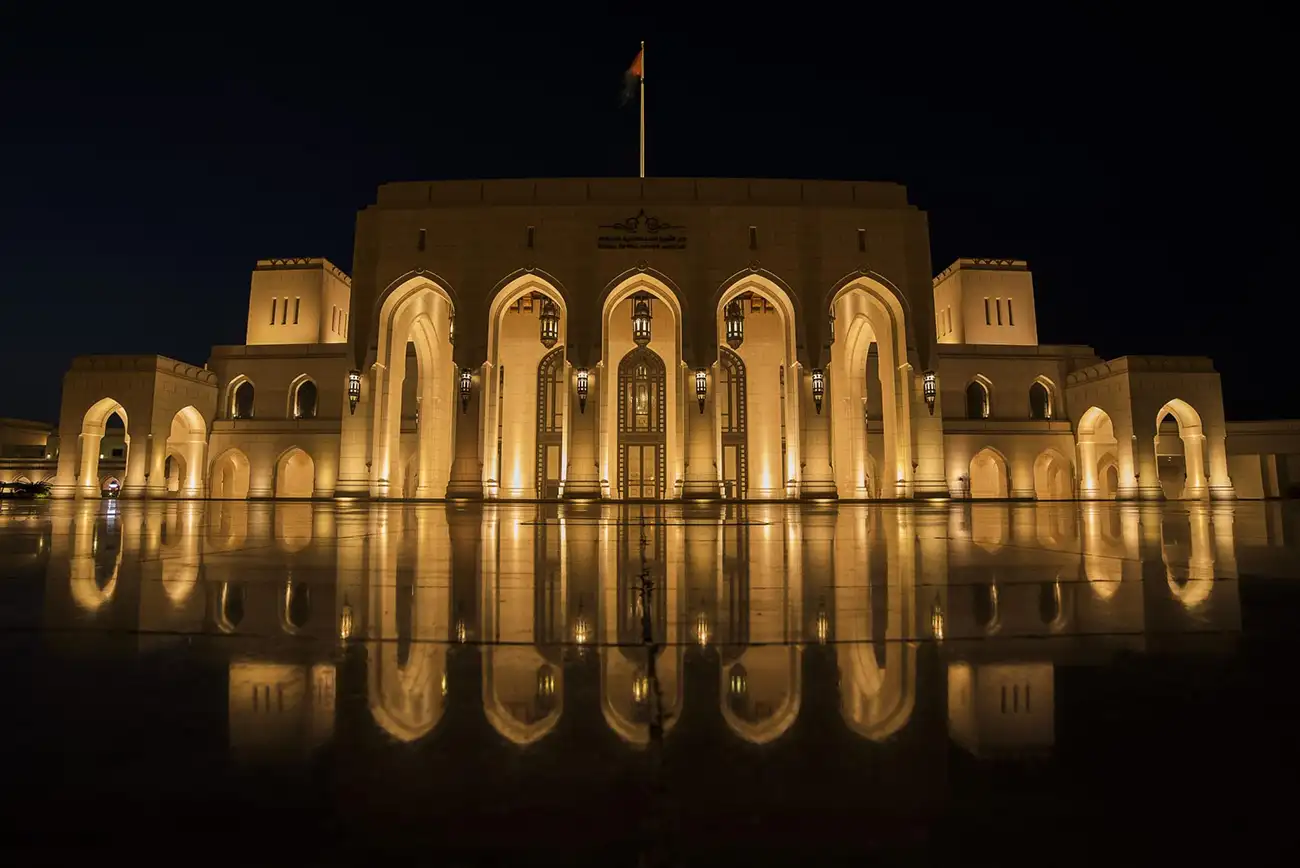
Exploring the Architecture and Design
The Royal Opera House Muscat merges Omani tradition with modern and Islamic architectural styles, creating a landmark that showcases Oman’s cultural wealth and embraces modern design. This landmark is a testament to the power of human ingenuity.
Architectural Style
- Blending Cultural Designs: The Royal Opera House Muscat skillfully integrates Omani architectural features with Islamic influences and contemporary design. This architectural harmony showcases Oman’s historical beauty while appealing to an international audience.
- Merging Old and New: Intricate details drawn from Oman’s rich history grace both the exterior and interior of the building, combined with sleek, contemporary elements that lend the structure a timeless elegance.
Use of Local Materials and Craftsmanship
- Local Limestone Construction: The primary use of locally sourced limestone gives the Royal Opera House Muscat a distinct appearance rooted in Omani tradition. The building’s facade features exquisite stonework, highlighting Oman’s exceptional craftsmanship.
- Artisan Craftsmanship: Inside, the opera house boasts intricately carved wood, detailed marble, and fine arabesque patterns, which enhance its luxurious and authentic cultural ambiance. Omani artisans were crucial in realizing these intricate designs, underlining the nation’s commitment to its artistic heritage.
Interior and Auditorium Features
- Design of the Grand Auditorium: The Royal Opera House Muscat’s grand auditorium, which seats more than 1,100 people, is at the heart of the building. Its design ensures superb acoustics and unobstructed views, offering an immersive experience to all visitors.
- Elegant Interior Accents: The original decor consists of crystal chandeliers, luxury upholstery, arms, and walls, and it is finished with fancy wooden elements, inviting an elite clientele. Such acoustics and visuals are also complemented by the latest technology, making the opera house one of the world’s most high-tech performing arts spaces.
- Versatile Cultural Venue: In addition to opera and concerts, the Royal Opera House Muscat accommodates various cultural events, including ballets and traditional Omani performances. Its design supports versatile use while maintaining a refined atmosphere.
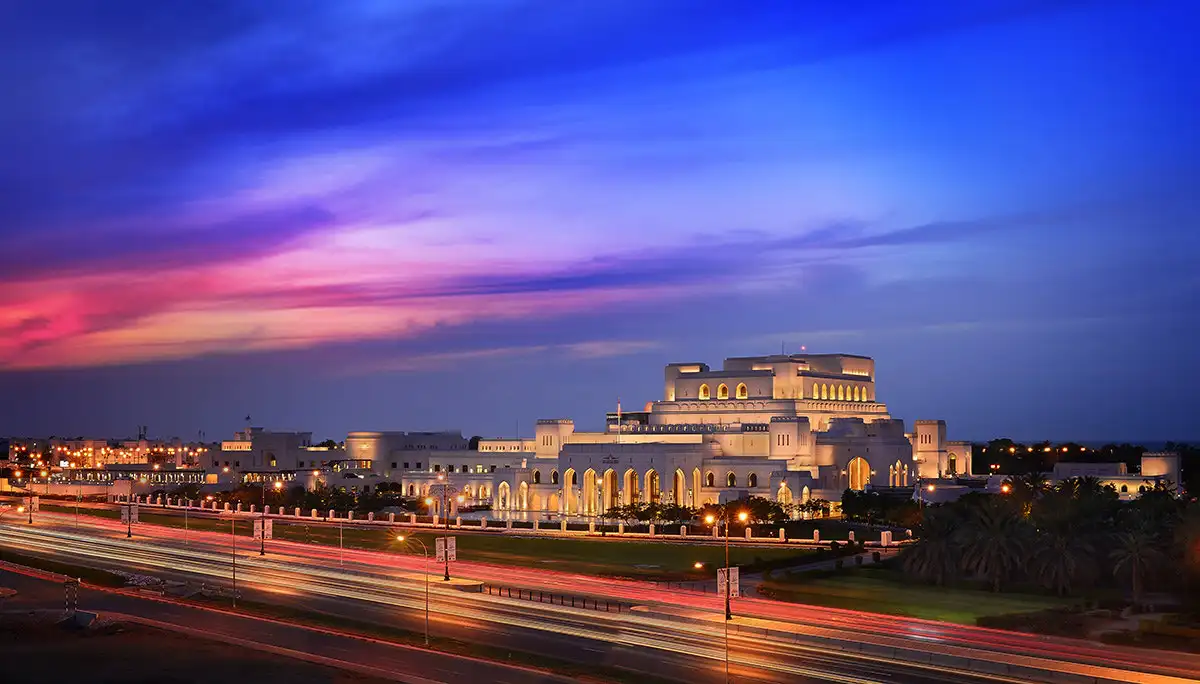
Exploring the Facilities and Features
The Royal Opera House Muscat is a significant cultural landmark and a center equipped with advanced, multifunctional spaces. Whether planning a cultural festival or a social gathering, this venue is the perfect choice.
Multifunctional Spaces
- Main Auditorium and Concert Theater: At the core of the Royal Opera House Muscat lies its expansive main auditorium, complemented by a smaller, intimate concert theater. These venues host various events, including operas, concerts, ballets, and plays, offering flexibility to support grand productions and smaller performances.
- Landscaped Gardens and Cultural Market: The Royal Opera House Muscat is nestled amidst serene gardens, offering guests a tranquil oasis to relax and connect. Moreover, the cultural market within the premises provides a rich mix of shopping options featuring traditional Omani crafts and global merchandise, enhancing visitors’ cultural engagement.
World-Class Acoustics and Technology
- Superior Acoustics and Seating Capacity: Known for its exceptional acoustics, the Royal Opera House Muscat elevates the auditory experience of its performances, making them deeply immersive. The auditorium, with approximately 1,100 seats, is meticulously designed to ensure every patron enjoys perfect sound quality and clear views.
- Cutting-Edge Technology: The Royal Opera House Muscat is outfitted with the latest sound and lighting technologies, delivering an unmatched audio-visual experience. This technology improves the quality of performances and provides versatility for different types of event configurations.
Additional Facilities
- Luxury Boutiques and Dining Options: The visitors shall also find many luxury boutiques that provide quality and rare brands in the building. Whether it is fine dining or simple laid-back eateries, many have them to please all.
- Cultural Shops: Properly constructed, the cultural shops at the Royal Opera House Muscat encourage visitors to return to a part of Omani culture. These shops depict numerous traditional Omani items, such as enhanced-dressed dolls, excellent gifts or personal items, and many other cute knickknacks.
Performances and Events at the Royal Opera House Muscat
The Royal Opera House Muscat delivers world-class performances for every artistic preference. From opera to Arabic music, the venue creates a cultural experience that is truly unique to Oman.
Types of Performances
- Opera: The Royal Opera House Muscat regularly hosts acclaimed opera performances featuring renowned companies and soloists worldwide. Audiences can enjoy everything from timeless works by Mozart and Verdi to more contemporary opera productions.
- Ballet: Expect performances with some of the best ballet troupes around. The theatre presents both classical ballet and modern ballet, where it is visually and artistically unforgettable.
- Classical Music Concerts: The talk of classical music and how it fills the auditorium is true since great soloists and orchestras are present. These concerts paint a picture filled with a variety of symphonic works, chamber works, and works for around one musician, thus nurturing classical music enthusiasts quite well.
- Jazz and World Music: The Royal Opera House Muscat captures global music traditions well since jazz and other world music are regularly available. Throughout every performance, consummate and award-winning jazz musicians and their fantastic cross-over style bands turn the stage into a display of many musical cultures.
- Arabic Music: The opera house is vital in celebrating Arabic music. Legendary artists from the region perform traditional and contemporary Arabic music, allowing visitors to experience the rich musical heritage of the Arab world.
- Theater: Muscat Theater offers classical and modern interactive performances at the Royal Opera House. It showcases theatrical pieces from different countries, which every theatergoer will surely appreciate.
Famous Performances and Artists
The Royal Opera House Muscat is a venue providing a platform for some great artists and groups worldwide. All the top Orchestras, the Vienna Philharmonic, London Symphony Orchestra, and Russian National Orchestra, have all graced its stage. For instance, in-house performances by Andrea Bocelli, Renée Flemming, and Placido Domingo have been unforgettable.
Ballet troupes such as the Bolshoi Ballet and the American Ballet Theatre have also been presented on this stage, thus bringing famous shows to Muscat. These activities have made the Royal Opera House Muscat a prime and central venue for events filled with art, attracting people from Oman and beyond.
Annual Performance Schedule and Notable Events
- Annual Season Schedule: The Royal Opera House Muscat devises an imaginative live performance schedule yearly. The season extends from September to May and consists of operas, concerts, ballets, or other theatre productions in turn or combination. The calendar lists activities enjoyable to everyone despite the demographics and types of arts presented.
- Festivals and Special Events: In addition to the routine performance, the Royal Opera House Muscat organizes a few festivals and special events from time to time. Without being exhaustive, these events may include an Arabic music festival, a jazz festival, a classical music festival, etc. These festivals are essential to the opera house, which is why many operas are sultry art institutions.
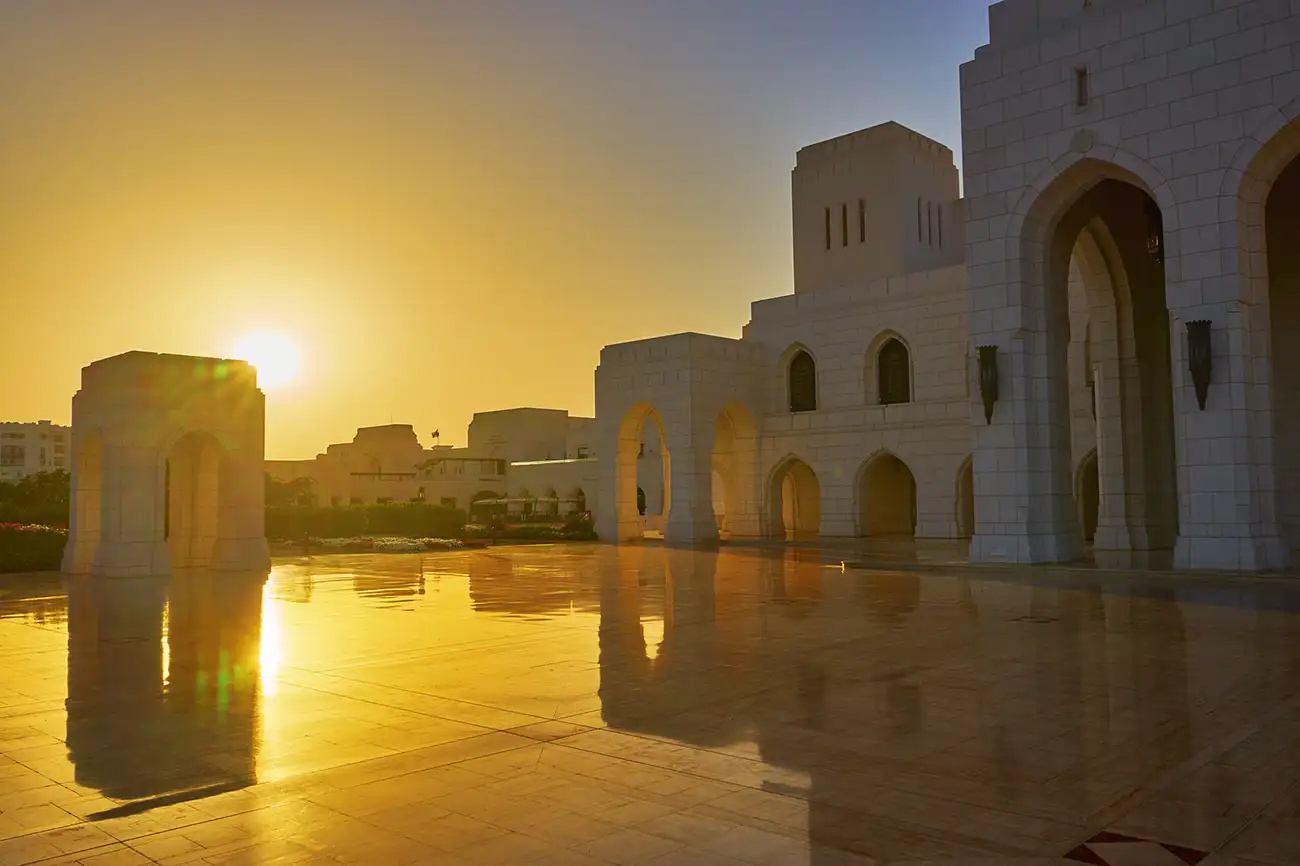
Cultural Significance
The Royal Opera House Muscat (ROHM) stands as a cultural beacon in Oman and on the global stage. It has been instrumental in showcasing Omani culture to the world and fostering a connection between traditional heritage and contemporary arts.
Promotion of Omani Culture on the International Stage
The Royal Opera House Muscat has become essential for promoting Oman’s culture. In this way, the ROHM has presented the longstanding traditions of the art of Oman’s ethnic groups to foreign tourists by organizing shows focused on traditional Omani music and related arts. It has enabled Omani musicians, dancers, and other stage performers to showcase their talents to the world, enhancing the cultural profile of Oman.
- Omani Music Performances: The opera house frequently features Omani artists, promoting local music and cultural expressions. These performances allow international audiences to experience Omani traditions firsthand.
- Cultural Diplomacy: ROHM fosters cultural exchange through collaborations with global artists. The Royal Opera House Muscat is primarily advancing Oman’s cultural diplomacy efforts.
Bridging Traditional Omani Heritage and Global Arts
ROHM plays a significant role in blending Oman’s traditional arts with international artistic movements. The opera house serves as a meeting point for local and global cultures, presenting diverse performances that balance Omani traditions and contemporary international art forms.
- Showcasing Global Talent: While emphasizing Omani heritage, the Royal Opera House Muscat hosts world-class performances from international artists. The platform allows global art forms to intersect with traditional Omani culture, fostering mutual appreciation.
- Collaborative Projects: ROHM often engages in collaborative projects where Omani and international artists perform together. The cultural dialogue between Oman and the world is enhanced, broadening the horizons of both artists and audiences.
Cultural Outreach and Education
The Royal Opera House Muscat takes pride in its mission to engage the Omani community and international visitors through cultural outreach programs, educational initiatives, and workshops. These programs cultivate a love of the arts and encourage young people to explore and embrace cultural heritage.
- Workshops and Masterclasses: ROHM regularly offers workshops and masterclasses led by renowned musicians, dancers, and artists. These educational opportunities are open to students and aspiring performers, encouraging the growth of artistic talent within Oman.
- Community Engagement: Within the scope of outreach activities, the Royal Opera House Muscat directs art and culture to the local communities, making it participatory; that is, everyone can access and appreciate it. Such programs include, amongst other things, educational performances, talks, and interactive art sessions for audience appreciation.
- Cultural Education: By offering these programs, ROHM reinforces its commitment to preserving Oman’s cultural heritage while educating the younger generation on traditional and modern art forms.
Visitor Information for the Royal Opera House Muscat
The Royal Opera House Muscat offers a rich blend of art, history, and luxury, making it a must-visit cultural destination. Visitors can enjoy world-class performances, explore the architecture through guided tours, and experience a variety of dining and shopping options. Below is all the practical information you need to plan your visit.
Location and Accessibility
It lies in the heart of Muscat’s Shati Al Qurum district. There are plenty of transportation options to get you to the opera house, including cars, taxis, and public transport.
- Address: Shati Al Qurum, Muscat, Oman.
- Parking: The opera house provides plenty of parking spaces, including areas designated for visitors with mobility needs.
- Public Transportation: Public buses and taxis make it convenient to reach the venue, with nearby stops for easy access.
Ticket Booking
Booking tickets for events at the Royal Opera House Muscat is easy, with options to book online or visit in person.
- Online Booking: Visit the opera house’s website to book your tickets. You can see what’s on and pick your seats there. Be sure to book in advance, especially for the big shows!
- Box Office: If you want to purchase a ticket physically, the ticketing box is open daily and operated by personnel who can help with any questions or requests.
Guided Tours
The Royal Opera House Muscat offers guided tours that take you behind the scenes and through the building’s impressive architecture and history.
- Tour Times: Tours are available at set times throughout the week. Be sure to check the official website for the latest schedule.
- What’s Covered: The tours include insights into the opera house’s design and history, with some tours even offering exclusive access to backstage areas. You’ll learn about the intricate architectural details and the story behind the creation of this cultural landmark.
- Cost: Tours are available for a small fee, with group discounts and special student rates often available.
Dining and Shopping Options
The Royal Opera House Muscat offers various food and shopping services as part of your experience.
- Restaurants: Some fine dining and casual restaurants within the premises serve multiple cuisines, including local Omani and international food, to meet everyone’s palate.
- Cafés: For a lighter meal or snack, cafés offer coffee, tea, pastries, and small bites in a relaxed atmosphere.
- Shopping: The Royal Opera House Muscat has high-end fashion and traditional shops. At this place, high-end fashion and cultural shops sell Omani works, textiles, pottery, and jewelry, which interested parties can browse, especially those who want to buy a piece of Oman to return home.
Future Vision of the Royal Opera House Muscat
The Royal Opera House Muscat (ROHM) remains a shining symbol of arts and culture in Oman, with ambitious plans to increase its local and global influence. As the leading cultural venue in the Sultanate, the opera house consistently brings world-class performances to Oman and fosters a deep appreciation for the arts within the community. Its plans focus on preserving its cultural legacy while embracing new opportunities to promote artistic expression.
Continued Role in Promoting Arts and Culture
The Royal Opera House Muscat continues to play a pivotal role in supporting the arts in Oman. The opera house bridges the gap between Oman’s rich heritage and the global art scene by showcasing local talent and welcoming international artists. ROHM will blend Oman’s traditional music and culture with contemporary artistic trends, fostering an appreciation for both.
- Cultural Leadership: In its strategy, the Royal Opera House Muscat intends to keep walking high as the region’s artistic and creative hub. Therefore, it will continue to program all entertainment genres, including opera, ballet, classical and contemporary music. These performances will bring rejuvenating and entertaining utmost artistic enjoyment to the audience.
- Nurturing Omani Talent: ROHM will remain dedicated to nurturing local talent by providing opportunities for emerging Omani artists to perform on its prestigious stage. This commitment ensures that future generations will carry on and preserve Oman’s cultural traditions.
- International Collaborations: As part of its ambitious vision, the Royal Opera House Muscat will intensify collaborations with foreign artists and cultural organizations. Such collaborations will complete the cycle for the global outreach initiative, bringing more performances into the country and, consequently, culture to the government, further promoting instability in the country and beyond on the international scene.
Anticipated Activities and Shows
It has many activities lined up for future seasons. These performances illustrate the opera house’s purpose of diversifying entertainment and sharing the arts locally and globally.
- Opera and Classical Performances: ROHM will still present numerous productions of learning the world together through modern musical and classic music concerts. Most of the performing stars and even the most famous orchestras will appear on its platforms to offer diverse kinds of music to the people in Oman.
- Cultural Festivals: The Royal Opera House Muscat has ambitions to conduct numerous cultural festivals, which will pay homage to various music and performing arts from all over the globe. Such festivals allow the local folk to understand and appreciate the different cultures worldwide.
- Memorable Omani Performances: Future seasons will feature performances designed to promote Omani culture among the local population. These shows will help the local people portray Oman’s multifaceted art to the tourists who visit the country.
Interesting Facts
The Royal Opera House Muscat offers much more than just performances. It represents Oman’s cultural pride and modern vision. Packed with fascinating details and unique features, it stands out as one of the world’s leading opera houses. Below are some lesser-known facts about the Royal Opera House Muscat.
Record-Breaking Performances
- First Opera House in the Arabian Peninsula: The Royal Opera House Muscat is the first opera house in the Arabian Peninsula, setting a standard for future cultural landmarks across the region.
- World-Class Performances: The opera house has hosted several record-breaking shows, including sold-out performances by international stars such as Andrea Bocelli and Plácido Domingo. These events have attracted visitors from across the globe, cementing Muscat’s place as a top cultural destination.
- Diverse Genres: The Royal Opera House Muscat embraces various genres, offering performances from classical operas and ballets to Arabic music and contemporary shows. This diversity makes it one of the few venues worldwide that successfully blends multiple cultures within its programming.
Collaborations with International Artists
- Global Partnerships: The Royal Opera House Muscat frequently collaborates with world-renowned international artists and cultural organizations. These partnerships have brought prestigious orchestras like the Vienna Philharmonic and acclaimed ballet companies like the Bolshoi Ballet to Oman, enriching the country’s cultural scene.
- Cultural Exchange: The opera house encourages cultural exchange by creating opportunities for Omani and international artists to perform together. These collaborations help strengthen Oman’s influence in the global arts community and offer audiences a genuinely diverse artistic experience.
Eco-Friendly Design Aspects
- Sustainable Architecture: One of the Muscat House’s least-known facts is its friendly design. The building incorporates energy-efficient systems, including advanced lighting systems and temperature controls, among others, thus reducing its environmental damage.
- Green Spaces: Beautifully landscaped gardens surround the opera house, enhancing its aesthetic appeal and promoting its eco-friendly ambiance. These green spaces provide visitors a serene environment to enjoy before and after performances.
- Recycling and Waste Management: The Royal Opera House Muscat follows sustainable waste management practices, ensuring that the venue contributes to Oman’s environmental goals.
Other Unique Features
- State-of-the-Art Acoustics: The Royal Opera House Muscat boasts cutting-edge acoustic technology, ensuring flawless sound quality for every performance. This advanced system elevates the audience experience, making the venue one of the most sophisticated performance spaces globally.
- Cultural Market and Boutiques: In addition to being a stage, the opera house includes a cultural market and high-end shops where fans can buy a range of Japanese decorative arts, clothing designs, and other luxurious goods. This aspect of Omani culture further enhances the visitors’ experience.
Conclusion: Why the Royal Opera House Muscat is a Must-Visit
The Royal Opera House Muscat is a premier destination for anyone interested in culture, the arts, or Omani heritage. Its stunning architecture, world-class performances, and deep commitment to promoting local traditions make it a cultural hub in Oman and the wider region. Visitors can enjoy various performances, from classical operas and ballets to Arabic music and contemporary shows, offering something for every taste.
A Cultural Icon in Oman
The Royal Opera House Muscat has significantly impacted Oman’s cultural and artistic scene. Hosting local and international artists has symbolized Oman’s cultural pride and vision. The House has preserved Oman’s culture of creativity but has also contributed to the development of local art, combining it with the world’s art. ROHM helps develop the local population, providing its stage for local productions and bringing in foreign artists.
Global Influence and Cultural Exchange
The Royal Opera House Muscat is also a key player in the performing arts scene. It has not only enhanced the country’s image but also affected the globalization process of Oman through its networks of prominent international artists and cultural institutions. There is a synthesis of regional and international art forms in the opera house because it promotes cultural diversity and has provided a venue for such cooperation.
